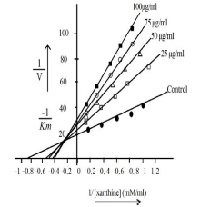Antioxidant, Anti-inflammatory and Xanthine oxidase inhibitory Activity of Tephrosia purpurea Plant Extracts
Keywords:
T. purpurea, Antioxidant, Anti-inflammatory, Xanthine oxidaseAbstract
T. purpurea whole plant extract (TPWPE) was evaluated for antioxidant, anti-inflammatory, and xanthine oxidase (XO) inhibitory activities. Antioxidant activity was measured using ABTS and FRAP methods, anti-inflammatory activity was measured by Diene-conjugate and β-glucuronidase assay. In vitro XO inhibitory activity was measured by using cow milk xanthine oxidase enzyme. The average antioxidant activity of TPWPE (1-2 µg/mL) in the reacting system revealed significant activity viz; 42.2 (ABTS) and 36.5 (FRAP) percent. The anti-inflammatory activities reveled, 45.40 and 70.50 percent inhibition. The result for XO inhibitory activity by plant extracts reveled, 95.5 % inhibition to that, off control (allopurinol) 92 % inhibition. The kinetic parameters of XO inhibition, revealed noncompetitive mode of inhibition, where, Km and Vmax of TPWPE extracts (25 to 100 µg/mL)) were, 0.25 mM/mL and 0.040, 0.036, 0.032 and 0.030 (µg/min) while for positive control Km and Vmax is 0.30 mM/mL and 0.045 (µg/min) respectively. Results suggest that, TPWPE can be exploited against diseases associated, with free radical formation and xanthine oxidase activity; further by isolation and structural elucidation of active phytochemicals from TPWPE.
References
. Pavana P, Sethupathy S, Manoharan
S. Protective role of T. purpurea
ethanolic seed extract on
glycoprotein components in
streptozotocin induced diabetic rat.
Int. J. Pharmacol. 2008; 4:114-119.
. Gopalakrishnan S, Vadivel E,
Dhanalakshmi K. Phytochemical
and pharmacognostical studies of
Tephrosia purpurea L aerial and root
parts. J. Herb. Med. Toxicol. 2009;
:73-78.
. Despande SS, Shah GB, Parmar NS.
Antiulcer activity of Tephrosia
purpurea in rats. Indian. J.
Pharmacol. 2003; 35:168–172.
. Mohamed-Elamir F, HegazyMohamed H, Abd El-Razek,
Fumihiro Nagashima, Yoshinori
Asakawa, Paul W. Rare prenylated
flavonoids from Tephrosia purpurea.
Phytochem. 2009; 70:1474–1477.
. Ames BN, Shigenaga MK. Oxidants
is a major contributor to aging. Ann
New York Acad Sci. 1992; 663:85-
. Esterbauer H, Striegl G, Puhl H,
Rotheneder M. Continuous
monitoring of in vitro oxidation of
human low density lipoprotein. Free
Rad. Res. Comm.1989; 6:67-75.
. Bjelakovic G, Nikolova D, Gluud LL,
Simonetti RG. Antioxidant
supplements are used for prevention
of several diseases. The. J. Am.
Med. Assoc. 2007; 297:842-857.
. Sies H. Oxidative stress: oxidants
and antioxidants. Exp Physiol.1997;
:291-295.
. Vertuani S, Angusti A, Manfredini S.
The antioxidants and proantioxidants network: an overview.
Curr. Pharma. Des. 2004; 10:1677-
. Mitchell RN, Cotran RS. Cell injury,
adaptation, and death. In: Kumar V,
Cotran RS, Robbins SL, Editors.
Robbins, Basic Pathology, 7th ed.
New Delhi: Harcourt (India) Pvt. Ltd.
; 2:3-33.
. Owen PL, Johns T. Xanthine
oxidase inhibitory activity of
Northeastern American plant
remedies used for gout. J.
Ethnopharmacol. 1999; 64:149-160.
. Parks DA, Grarger DN. Xanthine
oxidase: Biochemistry, distribution
and physiology. Acta. Phy. Scand.
; 548:87-99.
. Khairul FK, Nurul HM, Zhari I.
Antioxidative properties of various
extract of Labisia pumila (Kacip
Fatimah). Curr. Trends. Persp.
;
. Beris H. Antioxidant affects a basis
of drug selection. Drugs, 1991;
:569-605.
. Muthuswamy U, Kuppusamy A,
Arumugam S, Thirumalaisamy S,
Varadharajan S, Thenvungal KR,
Xanthine oxidase inhibitory activity
of some Indian medical plants. J
Ethnopharmacol. 2007; 109:547-
. Burda S, Oleszek W. Antioxidant
and antiradical activities of
flavonoids. J. Agric. Food Chem.
; 49:2774-2779.
. Hong Gao, Jun Nishida, Shizuka
Saito, Jun Kawabata. Inhibitory
Effects of 5, 6, 7-Trihydroxyflavones
on Tyrosinase, Molecules. 2007;
:86-97.
. Quist EH. Regulation of erythrocyte
membrane shape by Ca2+. Biochem.
Biophys. Res. Commun. 1980;
:631-637.
. Dodge JF, Mitchell G, Hanahan DJ.
The preparation and chemical
characteristics of hemoglobin-free
ghosts of human erythrocytes. Arch.
Biochem. Biophys. 1963; 100:119-
. Nia R, Paper DH, Essien EE,
Oladimeji OH, Iyadi KC, Franz G.
Investigation into in-vitro radical
scavenging and in-vivo antiinflammatory potential of Tridax
Procumbens. Niger. J. Physiol. Sci.
; 18:39-43.
. Khobragade CN, Bodade RG,
Shinde MS, Jaju DR, Bhosale RB,
Dawane BS. Microbial and xanthine
dehydrogenase inhibitory activity of
some flavones. J. Enz. Inhib. Med.
Chem. 2008; 23:341-346.
. Kreamer BL, Siegel FL, Gourley GR.
A novel inhibitor of betaglucuronidase: L-aspartic acid. Ped
Res. 2001; 4:460-466.
. Miller NJ, Johnston JD, Collis CS,
Rice-Evans C. Serum total
antioxidant activity after myocardial
infarction. Annals. Clin. Biochem.
; 34:85-90.
. Baskar R, Lavanya R, Mayilvizhi S,
Rajasekaran P. Free radical
scavenging activity of antitumor
polysaccharide fractions isolated
from Ganoderma licidum (Fr.) P.
Karst. Nat Prod Rad. 2008; 7:320-
. Huang D, Ou B, Prior L. The
chemistry behind antioxidant
capacity assays. J. Agric. Food.
Chem. 2005; 53:1841–1856.
. Prior RL, Cao G. In vivo total
antioxidant capacity: comparison of
different analytical methods. Free.
Rad. Biol. Med. 1999; 27:1173–
. Buenger J, Ackermann H, Jentzsch
A, Mehling A, Pfitzner I, Reiffen KA,
Schroeder KR. Wollenweber U. An
inter laboratory comparison of
methods used to assess antioxidant
potentials. Int. J. Cosmet. Sci. 2006;
:135–146.
. Winrow VR, Winyard PG, Morris CJ.
Blake DR. Free radicals in
inflammation: second messengers
and mediators of tissue destruction.
Brit. Med. Bull. 1993, 49:506-522.
. Savill J. Haslett C. Granulocyte
clearance by apoptosis in the
resolution of inflammation.
Sem.Cell. Bio. 1995; 6:385-393.
. Ito K, Kagaya H, Satoh I, Tsukamoto
G, Nose T. The studies of the
mechanism of anti-inflammatory
action of 2-(5-ethylpyridin-2-yl)
benzimidazole (KB-1043).
Arzneimittelforschung. 1982; 2:117-
. Shewfelt RL, Purvis AC. Toward a
comprehensive model for lipid
peroxidation in plant tissue
disorders. Hort. Sci. 1995; 30:213–



